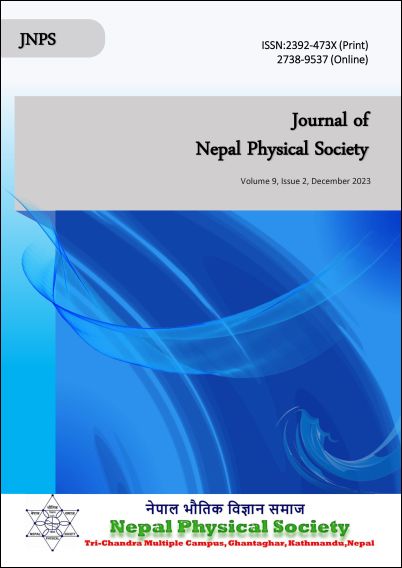Mn Doped ZnO Film for Ethanol Vapor Detection
DOI:
https://doi.org/10.3126/jnphyssoc.v9i2.62284Keywords:
Band gap, Ethanol vapor detection,, Operating temperature, Sensitivity, ZnO sensorAbstract
It has become a major challenge to develop highly sensitive and selective ZnO gas sensors to detect the leakage of toxic and explosive gases due to their high operating temperature. This article reports the design, characterization, and application of a Mn-doped ZnO thin film for ethanol gas vapor detection at a relatively lower temperature. To achieve this, undoped (0%) and Mn doped ZnO thin films were prepared using a spin coating technique and their structural, morphological and optical characterizations were carried out using XRD, SEM, EDX and UV-vis spectrophotometer. The XRD analysis showed a polycrystalline ZnO structure with the preferred orientations along (100), (002), (101), (102), (110), (103), and (200) planes. Upon Mn doping, the average crystallite size and band gap of ZnO were found to be decreased, which indicated that Mn ions substitute into the lattice of ZnO. Interestingly, SEM images revealed the grainy like porous ZnO surfaces. The EDX results confirmed the presence of Mn dopant in the ZnO lattice. In the doped films, the changes in particle size and grain boundaries of nanocrystalline ZnO resulted changes in sensitivity and operating temperature of ZnO gas sensor. The sensitivity measurements towards ethanol vapor showed significant decrease of the operating temperature from 220°C to 160°C as Mn concentration was increased from 0 to 5%. As-prepared Mn-doped ZnO sensors will be useful for sensing ethanol vapor at relatively low temperature.
Downloads
Downloads
Published
How to Cite
Issue
Section
License
All right reserved. No part of this Journal may be reproduced in any form or by any electronic or mechanical means, including information storage and retrieval system, without permission in writing from the publisher, except by a reviewer who may quote brief passage in a review. The views and interpretation in this journal are those of author(s) and they are not attributable to the NPS.




